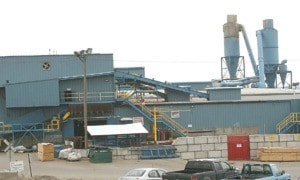Canfor Corporation reported net income of $32.3 million for the first quarter of 2011, compared to $55.4 million for the fourth quarter of 2010 and $35.5 million for the first quarter of 2010.
The company’s net income attributable to shareholders (“shareholder net income”) for the first quarter of 2011 was $7.0 million, or $0.05 per share, down from $31.4 million, or $0.22 per share, for the fourth quarter of 2010 and down from $18.3 million, or $0.13 per share, reported for the first quarter of 2010.
The company’s results for the first quarter of 2011 are presented in accordance with International Financial Reporting Standards (IFRS) for the first time, and comparative information in 2010 has been restated accordingly.
Full details of the adjustments resulting from the company’s conversion to IFRS, including reconciliations to amounts previously recorded for 2010 comparative periods under previous Canadian generally accepted accounting principles, are presented in the Company’s interim financial statements for the first quarter of 2011.
Shareholder net income for the first quarter of 2011 included several items affecting comparability with prior periods, which had an overall positive impact of $6.9 million, or $0.05 per share.
After adjusting for all items affecting comparability, the company effectively broke even in the first quarter of 2011.
Similarly adjusted shareholder net income for the fourth quarter of 2010 was $13.6 million, or $0.10 per share and adjusted shareholder net income for the first quarter of 2010 of $13.1 million, or $0.09 per share.
Reported EBITDA for the first quarter of 2011 was $72.9 million, down $10.6 million from the fourth quarter of 2010.
EBITDA for the lumber segment was $18.0 million, down $3.7 million from the previous quarter, while EBITDA for the pulp and paper segment decreased $2.4 million to $64.0 million.
Weaker panels results accounted for the majority of the remaining shortfall.
In the first quarter of 2011, a stagnant U.S. housing sector and severe winter weather conditions across much of North America weighed heavily on home construction activity and the Company’s ability to deliver lumber to customers. While the Company’s lumber production in the current quarter was up seven per cent, shipments of lumber were down three per cent reflecting the major disruption to transportation networks caused by the adverse winter conditions.
For offshore markets, lumber demand remained at high levels and continued to support higher prices for narrower dimensions in North America, with the average benchmark western SPF (spruce/pine/fir) 2x4 price up US$27, or 10 per cent, from the previous quarter.
As was the case in the previous quarter, however, these price increases were not replicated across wider dimensions and all higher grades. Northern bleached softwood Kraft (NBSK) pulp market conditions remained favourable in the first quarter, with list prices to North America and Europe approaching US$1,000 per tonne towards the end of the period.
Sales realizations across all products were negatively impacted by the strengthening of the Canadian dollar through the quarter.
Lumber unit manufacturing costs were down slightly from the previous quarter mostly reflecting more operating days with Christmas shuts taken in the prior quarter) and productivity gains, which offset increased log costs that reflected higher diesel and purchased wood costs.
Pulp unit manufacturing costs in the current quarter were also down, mostly as a result of lower whole log chip costs.
“We continue to believe that the road to recovery for the U.S. housing market is likely to be a long one, but we are clearly seeing the benefits of the work we
have done in developing our Asian markets, particularly China,” Canfor president and CEO Jim Shepard said.
Canfor’s strategic capital spending focus continued in the quarter. In addition to further work on the company’s Fort St. John sawmill and planer rebuild, the Company commenced several new high-return projects which form part of a
three year, $300 million capital investment program for its lumber operations.
“We are very pleased with the progress being made on our Fort St. John rebuild, which remains on schedule for completion in the second quarter,” Shepard added.
Despite a projected seasonal uplift in home construction and repair and renovation activity over the remaining spring months, the U.S. housing market is not forecast to show any significant recovery through the balance of the year given the current high levels of mortgage delinquencies, home foreclosures and home inventories. The Canadian housing market, although flat in the first quarter, is forecast to show moderate improvement in the second quarter.
The strength of demand from China is projected to continue through the balance of the year, while the near-term outlook for Japan is more uncertain in the aftermath of the devastating earthquake and tsunami in March.
The global softwood pulp market is forecast to remain tight through the second quarter of 2011 as demand remains solid with continued strong shipments to China. In addition, annual maintenance downtime coupled with extended outages in Canada due to several large capital projects funded under the Canadian Federal Government Green Transformation Program, are projected to curtail supply.
“The past four years have shown that Canfor has the strength to endure the worst markets in many decades,” Shepard, who retired at the company’s general meeting.
“That’s why I can confidently say that Canfor is ready to take advantage of the opportunities and respond to the challenges that lie ahead.
“I am very confident that this company will continue to prosper under the very able direction of the incoming president and CEO, Don Kayne, and the management team.
“The future of Canfor is in very capable hands.”
